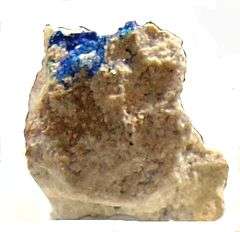Gilalite
| Gilalite | |
|---|---|
|
Blue Gilalite cystals | |
| General | |
| Category | Silicate mineral |
| Formula (repeating unit) | Cu5Si6O17·7(H2O) |
| Strunz classification | 9.HE.05 |
| Crystal system |
Monoclinic Unknown space group |
| Unit cell |
a = 13.38, b = 19.16 c = 9.026 [Å]; β ≈ 90°; Z = 4 |
| Identification | |
| Formula mass | 884.3 g/mol |
| Color | Blue green, green |
| Crystal habit | Raidiating fibrous in spherules |
| Tenacity | Waxy or gummy |
| Mohs scale hardness | 2 |
| Luster | Nonmetallic |
| Streak | Light green |
| Diaphaneity | Translucent |
| Specific gravity | 2.72 |
| Optical properties | Biaxial (-) |
| Refractive index | nα= 1.560 nβ=1.635 nΎ= 1.635 |
| Birefringence | δ = 0.075 |
| References | [1][2][3] |
Gilalite is a copper silicate mineral with chemical composition of Cu5Si6O17·7(H2O).[3]
It occurs as a retrograde metamorphic phase in a calc-silicate and sulfde skarn deposit. It occurs as fracture fillings and incrustations associated with diopside crystals.[2] It is commonly found in the form of spherules of radial fibers.

Gilalite inclusions within a quartz crystal from Juazeiro do Norte, Ceara State, Brazil (size: 7.1 x 4.7 x 2.7 cm)
It was first described for an occurrence in the Christmas porphyry copper mine in Gila County, Arizona in 1980 along with the mineral apachite.[4] It derives its name from this locality. It has also been reported from the Goodsprings District, Clark County, Nevada; Juazeiro do Norte, Ceara State, Brazil and a slag area in Lavrion District, Attica, Greece.[3]
References
- ↑ gilalite - Wolfram Alpha
- 1 2 Handbook of Mineralogy
- 1 2 3 Gilalite: Gilalite mineral information, Mindat.org
- ↑ F.P. Cesbron and S.A. Williams; March 1980;"Apachite and gilalite, two new copper silicates from Christmas, Arizona" Mineralogical Magazine, Vol. 43, pp. 639-41
This article is issued from Wikipedia - version of the 10/3/2016. The text is available under the Creative Commons Attribution/Share Alike but additional terms may apply for the media files.
